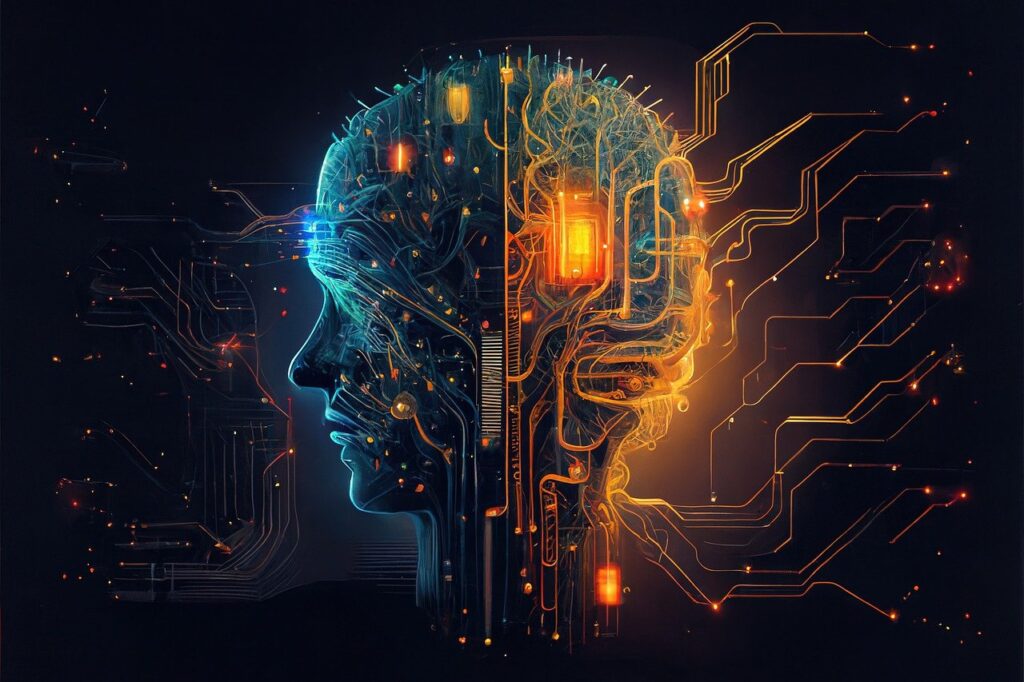Generative AI, short for Generative Artificial Intelligence, is a branch of artificial intelligence that focuses on creating models capable of generating new content that resembles human generated data.
Unlike traditional AI models that are designed for specific tasks, such as classification or prediction, generative AI models are intended to produce original and creative outputs. It involves using algorithms to create something new, such as images, text, music, or even videos, that resembles or mimics human creativity.
How Does Generative AI Work?
Generative AI uses various techniques like neural networks and deep learning algorithms to identify patterns and generate new results based on them. The training process for a generative model involves feeding it large dataset of examples such as images, text, audio, and videos. Then the model analyses the patterns and relationships within the input data to understand the underlying rules governing the content.
It generates new data by sampling from a probability distribution it has learned. It continuously adjusts its parameters to maximize the probability of generating accurate output. During inference, the model adjusts its output to better match the desired output or correct any errors. This ensures that the generated output becomes more realistic and aligns better with what the user wants to see.
Key Features of Generative AI
Generative AI, particularly in the context of language models like GPT-3, possesses several key features that distinguish it from traditional AI approaches :
- Natural Language Generation (NLG) – These models produce human-like text based on prompts, generating coherent and contextually relevant content, from sentences to entire articles.
- Adaptability – These models can be fine-tuned on specific tasks or domains, allowing them to adapt their outputs to different contexts or requirements. This flexibility makes them versatile tools across various applications, from customer service chatbots to creative writing assistants.
- Context Awareness – Generative AI can understand and incorporate context from preceding text, enabling it to generate responses that are coherent and relevant within a given conversation or document.
- Creativity – Unlike rule-based systems, generative AI can create novel outputs, including unique ideas, stories, and poetry, rather than merely rehashing learned patterns.
- Scalability – Capable of processing large datasets, these models can efficiently generate substantial amounts of content, making them ideal for extensive data applications.
- Continuous Learning – Some models support incremental learning, enabling them to improve and refine outputs over time based on new data and feedback.
Generative AI Models
Generative AI models are algorithms designed to generate new content. These models are trained on large datasets and learn patterns and structures within the data. They can then generate new data that are similar to the training data and they are capable of generating content without explicit human instructions or pre-programmed rules.
There are several types of generative AI models, including :
Generative Adversarial Networks (GANs)
GANs consists of two neural networks : a generator and a discriminator. The generator’s role is to create synthetic data, while the discriminator’s task is to differentiate between real and generated data. Through a competitive process, the generator gets better at producing realistic data as it learns from the feedback given by the discriminator.
GANs were invented by Jan Goodfellow and his colleagues at the University of Montreal in 2014. They described the GANs as architecture in the paper titled “Generative Adversarial Networks”. Since then there has been a lot of research and practical applications, making GANs the most popular generative AI model.
Variational Autoencoders (VAEs)
VAEs are a type of neural network that aims to learn the underlying distribution of the input data. They work by encoding the input data into a lower dimensional latent space and then decoding it back to generate new samples. Variational autoencoder was proposed in 2013 by Diederik P. Kingma and Max Welling at Google and Qualcomm.
Variational autoencoder provides a statistical manner for describing the samples of the dataset in latent space. Therefore, in the variational autoencoder, the encoder outputs a probability distribution in the bottleneck layer instead of a single output value.
Transformer Models
Transformers are a type of neural network architecture that has been highly successful in natural language processing tasks. They can generate human-like text by predicting the probability of the next word in a sequence given the preceding context. Some of the most well known examples of transformers are GPT-3 and LaMDA.
GPT-3 is a series of deep learning language models built by the OpenAI team – a San Francisco based artificial intelligence research laboratory. GPT-3 stands for generative pre-trained transformer model. The 3 here means that this is the third generation of those models. The model can produce text that looks like it was written by a human. It can write poetry, craft emails, and even crack jokes.
LaMDA (Language Model for Dialogue Applications) is a family of conversational neural language models built on Google Transformer- an open-source neural network architecture for natural language understanding.
A typical transformer consists of two parts:
The encoder works on the input sequence. It extracts all features from a sequence, converts them into vectors (e.g., vectors representing the semantics and position of a word in a sentence), and then passes them to the decoder.
The decoder works on the target output sequence. Each decoder receives the encoder layer outputs, derives context from them, and generates the output sequence.
Workflow of Generative AI

The workflow of Generative Al can be broken down into the following steps in brief:
Data Collection: This involves collecting a large dataset of examples representing the type of data you want to generate, such as images, text or audio.
Model Training: Choosing an appropriate generative model, such as GANs or VAEs and train it on collected dataset. During training, the model learns the patterns and structures present in the data.
Sampling: Once the model is trained, you can generate new data samples by providing random inputs or specific conditions to the generative model. The model will produce the output samples based on what it has learned from the training data.
Evaluation & Refinement: Evaluate the generated samples using various metrics and qualitative judgements. Adjust the model architecture, training process, or hyper parameters if necessary to improve the quality of the generated data.
Applications of Generative AI

Applications of generative Al are diverse and include:
Image Generation: Creating realistic images of objects, scenes, or people that do not exist in reality.
Text Generation: Generating human-like text for creative writing, chatbots or language translation.
Music Composition: Generating original music compositions in various styles.
Video Synthesis: Creating synthetic videos based on given inputs or scenarios.
Final Notes
Generative AI has shown impressive results and potential but it also comes with challenges such as ensuring the generated content is accurate, safe, and free from biases.
Ethical considerations are crucial when deploying generative AI models, as they could potentially be misused or create harmful content if not properly controlled. The technology is still advancing and researchers are constantly working to improve the quality and reliability of generative AI systems.
Thanks for reading!



